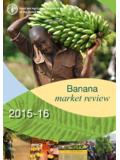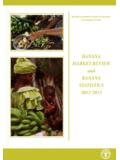Transcription of ORGANIC MILK MARKET REPORT - OMSCo
1 ORGANIC milk MARKET REPORT2017 ORGANIC milk MARKET REPORT 20172 Key Facts AboutOrganic Dairy FarmingFree Range No routine use of antibioticsCows fed a grass-rich,non-GMO diet No artificial fertilisers or herbicides usedon pastureHigher levels of key nutrients Omega 3 fatty acidsThe highest standards of animal welfareOrganic milk MARKET REPORT 20173 Strong growth in demand for ORGANIC dairy products in many developed and developing world markets is being driven by a common consumer focus on health and wellness. This is understandable in countries with fast growing wealth such as in parts of Asia, but even where austerity has patchily eroded disposable income consumers have sustained lifestyle choices such as eating out and buying food of choice.
2 However, growth in consumption of ORGANIC dairy products has not been homogenous, with demand in the USA for ORGANIC cheese and butterfat a key driver, while yoghurt in the UK and infant formula in China have led demand. National variations in growth also reflect local government and retail policy, with liquid sales in the UK only recently increasing, having battled for some time against very low conventional milk prices, while in France government public procurement policy requires support for organics. Despite these national differences, it is clear that where retail shelf space or online offers are available, sales grow significantly.
3 This is particularly the case when brands or retail own label demonstrate innovation and focus on quality rather than just basing their claims on ORGANIC credentials. Trends in consumer demand have many diverse drivers, but a common current feature is the desire to seek products that are simply without such as foods that claim as nature intended , pasture fed and especially in the USA a strong demand for certified GM free . In China the main demand is for safe, unadulterated foods. In addition, with the increasing patchy imposition of regulations surrounding Health Claims, on pack scientifically based claims have become harder to substantiate and this has opened the door for products that simply imply improved health such as alternative milks.
4 While all of these trends currently support the demand for ORGANIC dairy, it will be vital for the ORGANIC industry to recognise that quality control and science based evidence will increasingly alleviate consumer fear and ORGANIC dairy must continue to develop its own positive evidence to warrant increasing consumer demand. It is important to reinforce the message that ORGANIC dairy is pasture based, and managed well leads in providing balanced Omega 3 and trace elements resulting from modern ORGANIC pastures and stock is a good time for ORGANIC dairy with encouraging underlying consumer trends, increasing innovation and new product development.
5 If there are clouds on the horizon it will be the tendency to suffer periods of oversupply caused by the very nature of the extended conversion period from conventional to ORGANIC often resulting in large amounts of milk arriving at the same time and ahead of MARKET growth. Underlying MARKET growth will absorb emerging new supplies. The only question is how quickly. The UK is in balance and farmers appear to be sensibly evaluating the advantages of conversion against the absence of conversion grants, expensive ORGANIC feed and an adequately suppliedhome MARKET .
6 It would be impossible to end this short overview without mentioning the uncertainty surrounding Brexit, which hangs over the ORGANIC dairy industry as with the rest of agriculture and food as well as other manufacturing and service based industries. Perhaps the biggest uncertainty for ORGANIC dairy is not so much trade talks, tariffs and non-tariff issues, but the rather arcane subject of equivalence in standards. This seemingly peripheral issue needs to be addressed before the end of the Article 50 timetable and outside of Trade Agreements. If cheeses are to be produced for export markets extra mature and mature cheddar will need to be produced and matured in 2018 if it is to be available to support ongoing successful exports.
7 This requires acknowledgement that current equivalence regulations will continue to be summary, the indications are that the future remains bright, but it will undoubtedly provide ongoing challenges that will need to be met by one of the most innovative sectors of UK farming and food SaphirOMSCo ChairmanOrganic milk MARKET REPORT 20174 Executive SummaryThe global ORGANIC food and drink MARKET continues to show strong growth worldwide. The MARKET is valued at $82bn and grew 37% over the 5 years, from 2010. Globally, the largest single MARKET for ORGANIC is the USA, worth an estimated $38bn and growing at an annual rate of The European MARKET is worth $29bn and is growing by 15% year on year.
8 The growth drivers are similar across the world: Health & wellness and an increase in availability and choice. Another common feature of countries with a fast growing ORGANIC sector is the presence of a vibrant specialist ORGANIC retail network. There is no direct correlation between the largest markets and per capita consumption: The USA, the largest MARKET , ranks in 7th place in terms of per capita consumption compared with Switzerland, in 8th place in the size stakes but 1st place for consumption. ORGANIC exports are a growth area for many countries, in particular the Oceania region where exports out-perform domestic sales.
9 The UK MARKET performance has improved over the last 5 years. Valued at , and up , it continues to perform ahead of a non- ORGANIC food MARKET which is in slight decline. Globally, ORGANIC dairy is one of the largest sectors within ORGANIC food and drink worth $ and is also showing strong growth. UK retail ORGANIC dairy growth is however trailing that of other key markets. The USA is the largest MARKET with sales estimated over $6bn and growing 10% year on year. Within European markets, Germany and France are the largest and both are in strong growth.
10 The growth drivers of the dairy sector vary by country, for example, in Germany cheese is a dominant and growing sector, but in France the driver is milk . In China ORGANIC dairy still has a very small share of total sales but this represents a significant opportunity, subject to meeting changing Chinese regulations. UK ORGANIC dairy is worth 344m, and is growing ata rate of , behind total UK ORGANIC growth. Low relative conventional milk pricing and range rationalisation in ORGANIC yogurt have hinderedgrowth over the last milk MARKET REPORT 20175UK ORGANIC retail milk sales have recovered and over the last year there has been a significant increase in household penetration.






